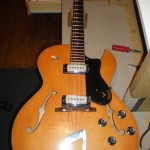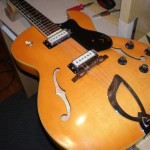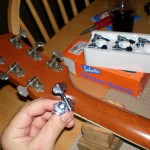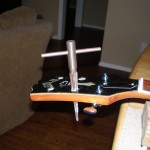Guild T100D Tuner Swap/Bone Nut Carve/Electronics Clean Up
 |
 |
 |
 |
 |
 |
 |
These are the projects I love to do. Upgrading old components, hot-rodding… whatever you want to call it, these are the ones I practically live for.
So, this guitar was purchased by it’s owner back in the 70’s and has remained solely in his possession since. While it was worked on a few times and the guitar was well cared for and thus, in great condition – with a few exceptions.
For starters the electronics were quite dusty and covered in crap. So much so, that the owner thought the switch needed replacing because it would short out every time he changed positions. After taking the electronics out (which on a hollow body like this, is not as fun as it sounds), it was clear to see the decades of dust that accumulated, causing the contacts on the pots to work intermittently. A quick spray over the components with some some contact cleaner and they were good as new.
This guitar’s owner also expressed an interest in upgrading the bridge and tuners. The current tuners would stick on certain strings, making the tuning process a pain. The bridge was nice enough, but the wooden saddle made the guitar play more as an acoustic and yielded brightness and sustain like a modern, metal guitar bridge.
After some research, we found a near-identical set of Shaller tuners and a floating tune-o-matic that could easily and quickly replace the older components.
I failed to take pictures of the process of the nut carving… but over the many years of use, this guitar’s plastic nut had worn itself down to the point of fretting out when the open G string was played. After an hour of sanding and filing some moose bone stock, the Guild had a new bone nut securely on it’s headstock and was the finishing touch to bringing this guitar a second life, which will last for decades to come.
